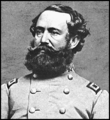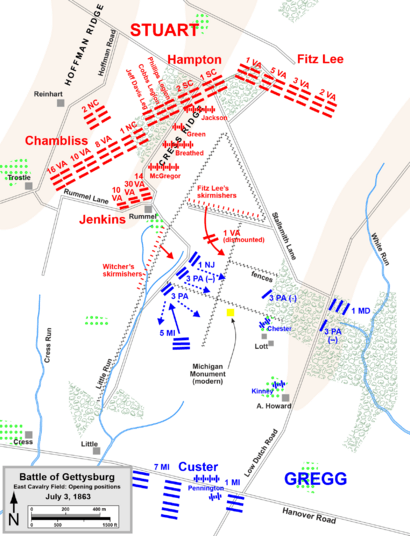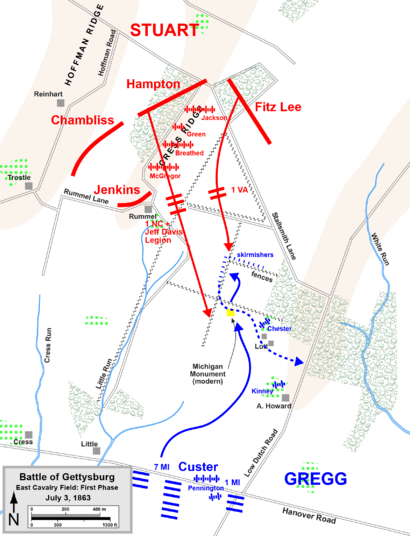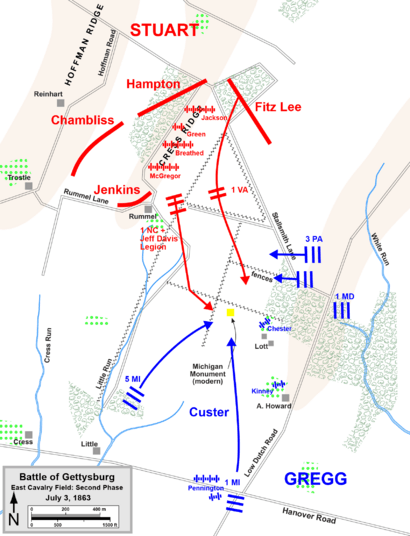Battle of Gettysburg, third day cavalry battles facts for kids
On the third day of the Battle of Gettysburg (July 3, 1863), a huge infantry attack called Pickett's Charge happened. But there were also two important cavalry battles. One was about three miles (5 km) east, in an area now called East Cavalry Field. The other was southwest of Big Round Top mountain, sometimes called South Cavalry Field.
The fighting at East Cavalry Field was an attempt by Confederate Maj. Gen. J.E.B. Stuart to get behind the Union army. He wanted to cause chaos if Pickett's Charge succeeded. But Union cavalry, led by Brig. Gens. David McMurtrie Gregg and George Armstrong Custer, stopped the Confederates.
At South Cavalry Field, after Pickett's Charge failed, Brig. Gen. Hugh Judson Kilpatrick ordered some risky cavalry attacks. These charges against the Confederate army's right side were easily stopped. Sadly, Union Brig. Gen. Elon J. Farnsworth was killed during these attacks.
Contents
Cavalry Forces and What Happened Before
How the Armies Were Set Up
Cavalry (soldiers on horseback) played a big part in the Battle of Gettysburg on the first and third days. On July 1, Union Brig. Gen. John Buford's cavalry division bravely held back Confederate infantry. This gave the Union foot soldiers time to arrive. After that, Buford's troopers left the field.
Most of Confederate Maj. Gen. Stuart's cavalry division was not at Gettysburg until late on the second day. Stuart had ridden his best cavalry brigades on a long trip around the Union Army of the Potomac. He was out of touch with Gen. Robert E. Lee's main army for many days. This meant Lee didn't get important information or protection. Stuart finally arrived on July 2, but his tired brigades were too late to help with the second day's battle.
Lee told Stuart to get ready for July 3. Stuart's job was to support the Confederate infantry attack on the center of the Union line. He also had to protect the Confederate left side. Then, he was to try and get around the Union right side and attack from behind. If Stuart could reach the Baltimore Pike, he could cause a lot of trouble for the Union army. This would help the main attack (Pickett's Charge) on the Union center.
Confederate cavalry for this mission included brigades led by Brig. Gen. Wade Hampton III, Brig. Gen. Fitzhugh Lee, and Col. John Chambliss. Also, Col. Milton J. Ferguson led a brigade after Col. Albert G. Jenkins was hurt. These four brigades should have had about 5,000 men. But probably only about 3,430 men and 13 cannons fought that day. After riding for nine days, their horses were very tired.
Union cavalry was led by Maj. Gen. Alfred Pleasonton. He didn't directly command any cavalry actions at Gettysburg. Most of Buford's division had left the area. So, only two Union cavalry divisions were ready to fight. Brig. Gen. David McMurtrie Gregg's division was right in Stuart's path. Gregg had two brigades, but one was elsewhere. So, his command was joined by Brig. Gen. George Armstrong Custer's new "Michigan Brigade." Custer was usually with Brig. Gen. Hugh Judson Kilpatrick's division. But he asked Gregg if he could join this fight. In total, about 3,250 Union troopers faced Stuart. The other brigade from Kilpatrick's division, led by Brig. Gen. Elon J. Farnsworth, was southwest of Round Top mountain. This is the area known as South Cavalry Field.
Main Cavalry Leaders at Gettysburg, July 3
-
Maj. Gen.
J.E.B. Stuart, CSA -
Brig. Gen.
Wade Hampton, CSA -
Brig. Gen.
Fitzhugh Lee, CSA -
Maj. Gen.
Alfred Pleasonton, USA -
Brig. Gen.
David McM. Gregg, USA -
Brig. Gen.
George A. Custer, USA -
Brig. Gen.
Judson Kilpatrick, USA -
Brig. Gen.
Elon J. Farnsworth, USA
East Cavalry Field Battle
Around 11:00 a.m. on July 3, Stuart reached Cress Ridge. This was just north of what is now East Cavalry Field. He fired four cannons to tell Lee he was ready. But this also told Gregg where he was. Gregg had McIntosh's and Custer's brigades ready to stop Stuart. As the Confederates came closer, Gregg's cannons started firing. The Union artillerymen were better, and Stuart's cannons were no match.
Stuart wanted to pin down the Union skirmishers (small groups of soldiers) near the Rummel farm. Then he planned to go around their left side. But the Union skirmishers fought hard. The soldiers from the 5th Michigan Cavalry had special repeating rifles. These guns gave them much more firepower. Stuart decided to try a direct cavalry charge to break through. He ordered an attack by the 1st Virginia Cavalry.
The battle truly began around 1:00 p.m. This was the same time that the Confederate artillery started firing heavily on Cemetery Ridge. Fitz Lee's troopers rode through the John Rummel farm. They scattered the Union skirmish line.
Gregg told Custer to counterattack with the 7th Michigan. Custer personally led his regiment. He yelled, "Come on, you Wolverines!" Waves of horsemen crashed into each other. They fought fiercely along a fence line at Rummel's farm. Seven hundred men fought very close, using carbines, pistols, and sabers. Custer's horse was shot, but he quickly got another one. Finally, enough of Custer's men broke the fence. This made the Virginians retreat. Stuart sent more soldiers from all three of his brigades. Custer's chase was stopped, and the 7th Michigan had to fall back.
Stuart tried again to break through. He sent in most of Wade Hampton's brigade. They started walking, then sped up to a gallop. Their sabers flashed, and Union soldiers even admired their bravery. Union cannons tried to stop them with shells and canister shot. But the Confederates moved too fast. They kept their speed even as men fell. Again, the cry "Come on, you Wolverines!" was heard. Custer and Col. Charles H. Town led the 1st Michigan Cavalry into the fight. They also rode at a gallop.
A Union soldier from Pennsylvania watched what happened:
As the two columns approached each other the pace of each increased, when suddenly a crash, like the falling of timber, betokened the crisis. So sudden and violent was the collision that many of the horses were turned end over end and crushed their riders beneath them.
While the horsemen fought hard in the middle, McIntosh led his brigade against Hampton's right side. Other Union soldiers hit Hampton's left side. Hampton was badly cut on the head by a saber. Custer's second horse of the day was shot. Attacked from three sides, the Confederates had to pull back. The Union troopers were too tired to chase them far.
The fighting at East Cavalry Field lasted 40 intense minutes. The losses were not huge: 254 Union soldiers were hurt, and 181 Confederates. The battle didn't have a clear winner in terms of who held the ground. But it was a big loss for Stuart and Robert E. Lee. Their plan to attack the Union from behind had failed.
South Cavalry Field Battle
On the morning of July 3, Union Cavalry Corps commander Maj. Gen. Alfred Pleasonton sent two of his brigades to the left side of the Union army. He ordered Brig. Gen. Wesley Merritt's brigade to move north. They were to join Brig. Gen. Hugh Judson Kilpatrick's division. Kilpatrick's men were moving to the area southwest of Big Round Top. At this time, Kilpatrick's division only had Brig. Gen. Elon J. Farnsworth's brigade. Custer's brigade was helping David Gregg at East Cavalry Field.
It's not clear what Pleasonton wanted to do. There is no record that he checked the area first. Some people think Union Army commander George Meade was getting ready for a possible counterattack. He expected Pickett's Charge to fail.
Farnsworth arrived around 1:00 p.m. This was about when the huge Confederate artillery attack began for Pickett's Charge. Farnsworth's 1,925 soldiers took a position south of the George Bushman farm. His regiments were the 18th Pennsylvania Cavalry, the 1st West Virginia, and the 1st Vermont. A cannon battery was on a small hill behind them. The 5th New York cavalry guarded the cannons. Kilpatrick joined them. They waited for Merritt's brigade. Merritt arrived around 3:00 p.m. and took a position near the Emmitsburg Road. By this time, Pickett's Charge had started. Kilpatrick was very eager to get his men into the fight.
On the Confederate side, east of the Emmitsburg Road, only infantry (foot soldiers) were involved. Four brigades from Hood's division, led by Brig. Gen. Evander M. Law, had been in this area since July 2. Law first had only the 1st Texas Infantry facing Farnsworth. But he soon sent more soldiers: the 47th Alabama Infantry, the 1st South Carolina, and cannons. West of the road, facing Merritt, was the Georgia brigade of Brig. Gen. George "Tige" Anderson.
Young Kilpatrick didn't have much experience leading cavalry. He showed this by attacking strong infantry positions one small group at a time. West of the road, Merritt's 6th Pennsylvania cavalrymen attacked first. They fought on foot. Anderson's Georgians easily stopped their attack. Farnsworth was supposed to attack next. But he was shocked when Kilpatrick ordered a mounted cavalry charge. The Confederate soldiers were behind a stone fence. Wooden fence rails were piled high on top of it. This was too high for horses to jump. The attackers would have to get off their horses under fire and take down the fence. The ground was also rough, with big rocks, fences, and woods. It was not good for a cavalry charge.
Stories differ about the argument between Farnsworth and Kilpatrick. But most believe Kilpatrick dared or shamed Farnsworth into making the charge. Farnsworth knew it would be a disaster. He supposedly said, "General, if you order the charge I will lead it, but you must take the awful responsibility."
The first to attack was the 1st West Virginia Cavalry. They rode in great confusion because they came under heavy fire from the 1st Texas. But they managed to break through the wall. Hand-to-hand fighting happened with sabers, rifles, and even rocks. But the attack was pushed back. Out of 400 Union cavalrymen, 98 were hurt. The second wave came from the 18th Pennsylvania. They were also turned back by heavy rifle fire.
Finally, it was the turn of the 1st Vermont Cavalry. About 400 officers and men were in this group. Farnsworth split them into three smaller groups. One group led the charge. They rode past the Texans and headed north. Evander Law sent three Georgia regiments to help the Texans and the cannons. An Alabama officer yelled, "Cavalry, boys, cavalry! This is no fight, only a frolic, give it to them!" The infantrymen found many easy targets.
All three attacks were turned back with many losses. The last group, led by Maj. William Wells and Farnsworth, circled back toward Big Round Top. There, they met a line of the 15th Alabama. Farnsworth's group had only ten troopers left. They rode back and forth, trying to avoid the deadly fire. Farnsworth fell from his horse, hit by five bullets. Maj. Wells received the Medal of Honor for bravely leading the rest of his men to safety. The Vermont regiment lost 65 soldiers in this useless attack.
Kilpatrick's poorly planned cavalry charges are remembered as a low point for the U.S. cavalry. They marked the last major fighting at the Battle of Gettysburg. Six miles (10 km) west of Gettysburg, one of Merritt's regiments was defeated. This happened at Fairfield by Confederate Brig. Gen. William E. "Grumble" Jones's brigade. This action is not usually part of the Battle of Gettysburg. But it was important for Lee's army as they retreated.
All of Pleasonton's cavalry brigades were used for the rest of the Gettysburg Campaign. They had a rather weak chase of Lee's army back across the Potomac River.













